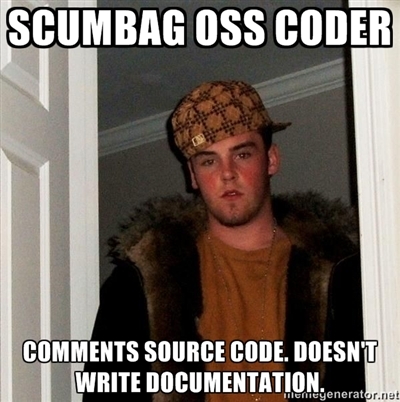Annotated Source Code As Documentation, With Docco
With the first bits of my Backbone.Marionette plugin being available on Github now, I wanted to try out the Backbone-style of annotated source code as documentation. I like the way Backbone has this set up, and I often refer to it when I want to know how something works internally, or find a specific piece of code to copy.
You can find the annotated code for Backbone.Marionette here.
Note that this only part of the documentation solution for a project, though. If you expect to annotate your source code and call your documentation done, you’re a scumbag oss coder:

That being said… commenting your code is a great way to provide additional documentation. It will help people understand the code they are reading, and help them write better code using your library or framework.
Docco
To generate the annotated document for Backbone.Marionette, I used Jeremy Ashkenas’ “Docco” tool – the same one he uses to generate Backbone’s annotated source code. The great thing about this project site: it’s build using the Docco tool. 🙂
There are a number of different ports for this tool available, so you can run it in NodeJS, Ruby, Python, .NET and more. I decided to use the NodeJS version that Jeremy built, mostly because I’m always looking for an excuse to use NodeJS tools. The process of getting this up and running was surprisingly simple, though it did involve a few steps and a bit of guess work on my part. Hopefully this blog post will help others get around the guess work.
The Source Code
If you read through the source code for Backbone.Marionette, you’ll find a bunch of standard // comments throughout the code. This is pretty normal stuff, for the most part. I’ve added some comments above my objects and methods, to help explain what they are and how to call them.
The only significant difference between a normal command and a Docco ready comment is that some of the comments have a //————— line underneath of them. This tells Docco that this is going to be a section header, in the compiled documentation. Using a fixed with font, set the number of – in that comment line to the same width as your header title:
Other than that, comment your code as you normally would. You can also do some cool tricks like using `bacticks` around code, and the generated document will encompass that inside of a <code> tag, with CSS set accordingly. There’s likely some other tricks you can do, too, as this is all run through a Markdown processor to build the docs.
Side note: if you haven’t learned Markdown yet, do yourself a favor and learn it. It’s becoming the ubiquitous documentation and code commenting style around the development community. I think this is largely due to Github supporting it and encouraging it’s use in readme files and Github wiki pages. I’m at the point where I take notes in Markdown, when attending technical sessions or taking notes from conversations.
Docco Prerequisites
There are a few things you’ll need to install if you want to use the NodeJS version of Docco:
- NodeJS
- NPM (Node Package Manager)
- CoffeeScript
- Python
- Pygments
If you’re on a Windows machine, you can find installation instructions for NodeJS, NPM and Python around the web fairly easily. Here’s the instructions for OSX:
NodeJS (via Homebrew):
NPM:
CoffeeScript:
Python:
May be included in OSX… might be part of XCode. I’m on OSX Lion and I have the latest XCode. I didn’t need to install anything for Python to be available to me. Python is needed for the “easy_install” tool, which is Python’s package manager (similar to NPM or RubyGems).
Pygments:
I’m not actually sure if you need to install the NPM pygments… I did, and things worked well for me. I’m assuming this is needed so NodeJS can run the Pygments tool.
Installing Docco
Once you have all the prerequisites in place, installing Docco is a one liner:
Now you have access to the `docco` command line tool.
Running Docco On Your Code
This is super easy. Just run `docco {file pattern}` from the command line. For example, the above `comments.js` file can be run like this:
You can also use file patterns such as `*.js`
Setting Up A Rake Task
I don’t like to run things manually when I don’t have to. Since my Marionette project uses Sinatra and Rake to run it’s Jasmine test suite, I decided to create a Docco task. Here’s what that would look like, for the above comments.js file:
Now I can run `rake docco` from the command line and it will build the docs for me. … yeah, this is probably overkill, but I wanted to do it anyways. 🙂
The Results
Here’s the results of running Docco against the above comments.js file (view it here, if you’re in an RSS reader):
